
Epacris impressa, also known as common heath, is a species of plant in the heath family Ericaceae. It is native to south-eastern Australia. French botanist Jacques Labillardière collected the species in 1793 and described it in 1805. Four forms have been identified, but no subspecies are recognised. Growing in heathland, shrubland or open forest, it is generally a small shrub around 0.5 to 1 m tall, with small stiff leaves. The red, pink or white tube-like flowers appear from late autumn to early spring. Honeyeater birds, particularly the eastern spinebill, feed upon the nectar of the flowers. It regenerates after bushfire by seed or by resprouting.
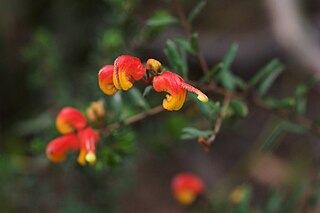
The Australian flowering shrub Grevillea alpina has several common names, including mountain grevillea, alpine grevillea, and cat's claws. It is not limited to alpine environments, and in fact is less common at high elevation than low. The species is variable in appearance, with five general forms described: small-flowered, Grampians, Northern Victorian, Goldfields, and Southern Hills forms. It is found in dry forests and woodlands across Victoria and into southern New South Wales. Some forms of the plant are low to the ground, and some become a spreading shrub. The flowers come in many colours, from white to green to shades of red and pink, or a pattern of several colours. The curled flowers are 1 to 3 centimetres in length. It is attractive to nectar-feeding insects and birds.
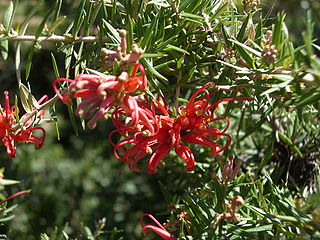
Grevillea juniperina, commonly known as juniper- or juniper-leaf grevillea or prickly spider-flower, is a plant of the family Proteaceae native to eastern New South Wales and southeastern Queensland in Australia. Scottish botanist Robert Brown described the species in 1810, and seven subspecies are recognised. One subspecies, G. j. juniperina, is restricted to Western Sydney and environs and is threatened by loss of habitat and housing development.

Grevillea armigera, also known as prickly toothbrushes or thorny grevillea, is a species of flowering plant in the family Proteaceae and is endemic to the south-west of Western Australia. It is an erect to spreading shrub with deeply-lobed leaves, the lobes linear and sharply pointed, and grey, green or pale yellow flowers with black to maroon styles.

Grevillea acanthifolia, commonly known as the Acanthus-leaved grevillea, is a plant in the family Proteaceae and is endemic to New South Wales. It is a shrub with stiff, prickly, divided leaves and pink to purple "toothbrush" flowers.

Grevillea bipinnatifida, commonly known as fuchsia grevillea, is a species of flowering plant in the family Proteaceae and is endemic to the south-west of Western Australia. It is a spreading shrub, usually with bipinnatifid leaves and loose clusters of dull pink to crimson flowers.
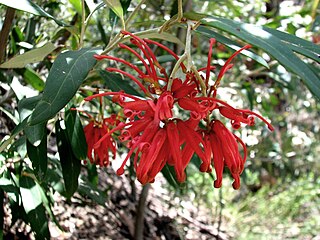
Grevillea victoriae, also known as royal grevillea or mountain grevillea, is a species of flowering plant in the family Proteaceae and is endemic to mountainous regions of south-eastern continental Australia. It is an erect to spreading shrub with elliptic to lance-shaped leaves, and pendulous clusters of red to orange flowers.

Grevillea lavandulacea, commonly known as lavender grevillea, is a species of flowering plant in the family Proteaceae and is endemic to southern continental Australia. It is a prostrate to spreading shrub with linear to elliptic leaves and clusters of pink to red flowers.

Grevillea barklyana, also known as gully grevillea or large-leaf grevillea, is a species of flowering plant in the family Proteaceae and is endemic to Western Gippsland in Victoria, Australia. It is an erect shrub or small tree, with mostly pinnatifid leaves with two to eleven lobes, and whitish pink to fawn flowers.

Grevillea microstegia, commonly known as Mount Cassell grevillea, is a species of flowering plant in the family Proteaceae and is endemic to Victoria in Australia. It is a prostrate to low-lying or straggling shrub with deeply divided leaves, the end lobes triangular, and toothbrush-shaped clusters of reddish-brown flowers with a red style.

Grevillea annulifera, also known as prickly plume grevillea, is a species of flowering plant in the family Proteaceae and is endemic to northern Western Australia. It is a spreading to erect shrub with pinnatisect leaves with five to nine sharply-pointed, linear lobes, and cream-coloured to pale yellow flowers.
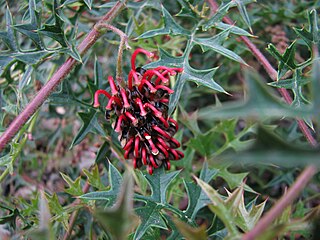
Grevillea montis-cole, commonly known as Mount Cole grevillea, is a species of flowering plant in the family Proteaceae and is endemic to central-western Victoria, Australia. It is a shrub with divided leaves with 5 to 15 lobes, the end lobes more or less triangular to narrowly oblong and sharply-pointed, and clusters of greenish to fawn and dull purplish flowers.

Grevillea australis, commonly known as alpine grevillea or southern grevillea, is a species of flowering plant in the family Proteaceae and is endemic to south-eastern Australia. It is a spreading to prostrate shrub with simple, narrowly egg-shaped leaves and groups of white to pale pink flowers with a glabrous ovary.

Grevillea gariwerdensis is a species of flowering plant in the family Proteaceae and is endemic to Grampians National Park in Victoria, Australia. It is a shrub with more or less linear to narrowly oblong leaves, and white to pink flowers with brownish hairs.
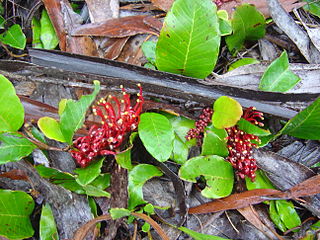
Grevillea laurifolia, commonly known as laurel-leaf grevillea, is a species of flowering plant in the family Proteaceae and is endemic to New South Wales. It is a prostrate, trailing shrub with egg-shaped, heart-shaped or round leaves, and clusters of reddish to deep maroon flowers.

Grevillea confertifolia, commonly known as Grampians grevillea or dense-leaf grevillea, is a species of flowering plant in the family Proteaceae and is endemic to the Grampians in Victoria, Australia. It is a spreading, often dense shrub with linear to narrowly oblong leaves, and reddish-purple flowers.

Grevillea ilicifolia, commonly known as holly grevillea or holly bush, is a species of flowering plant in the family Proteaceae and is endemic to southern continental Australia. It is a spreading to prostrate shrub with holly-like leaves with sharply-pointed triangular to egg-shaped teeth or lobes, and clusters of green to cream-coloured and mauve flowers with a pink to red style.

Grevillea angustiloba, commonly known as dissected holly-leaf grevillea, is a species of flowering plant in the family Proteaceae and is endemic to southern continental Australia. It is a prostrate, low-lying or erect shrub with deeply divided pinnate leaves and usually red, sometimes orange or pale yellow flowers.

Grevillea brevifolia, commonly known as Cobberas grevillea, is a species of flowering plant in the family Proteaceae and is endemic to south-eastern continental Australia. It is a spreading shrub with hairy branchlets, elliptic leaves and clusters of hairy red flowers.
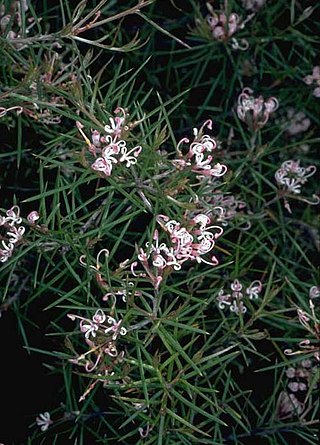
Grevillea halmaturina is a species of flowering plant in the family Proteaceae and is endemic to South Australia. It is a prickly, spreading to erect shrub with sharply-pointed, linear to more or less-cylindrical leaves and large groups of white to pale pink flowers.





















